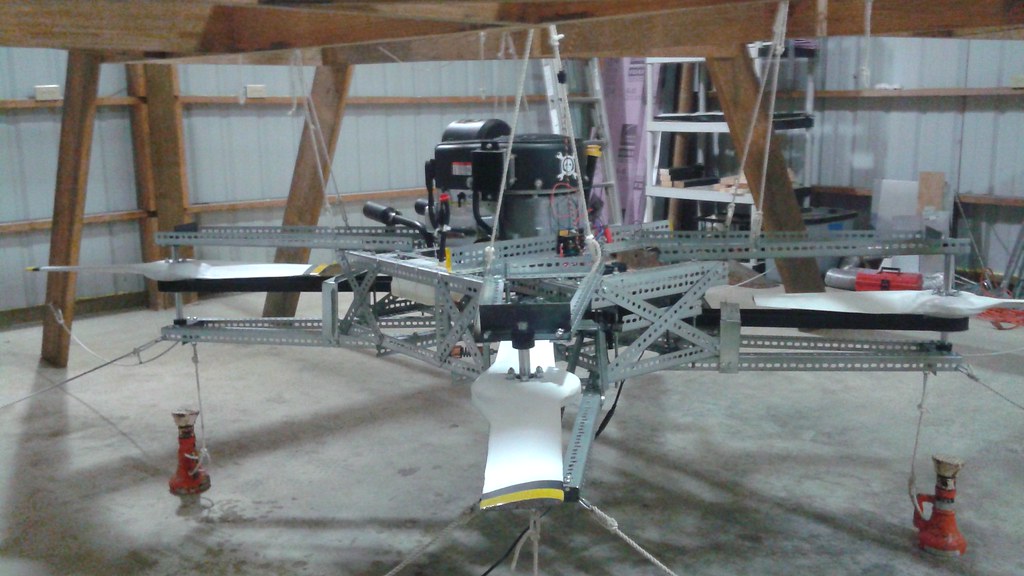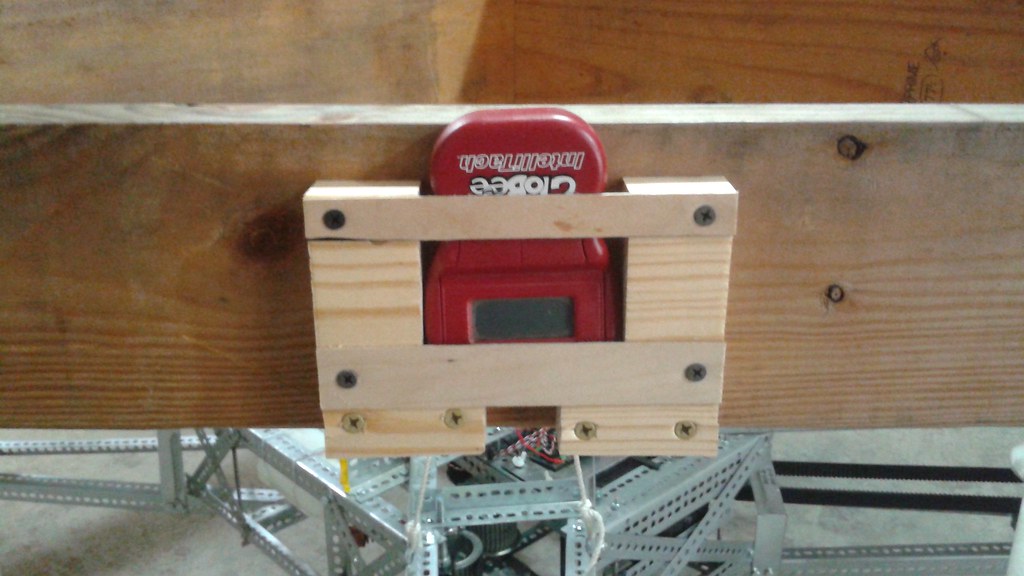A few tests back (Test 41), one of the rotor axles snapped, resulting in one of the rotors being damaged. The fix to this issue was to increase the shaft diameter to 3/4" from 5/8" and switch from using E-clips to retaining rings (project log with more details). Below is the new shaft with retaining rings holding the pulley in place.

A new rotor was built to replace the one that was damaged when the axle snapped. Both counter-clockwise propellers got a new paint job to make the tips more visible. Eventually the other set of propellers will get the same set of markings.
 With all of the hardware fixed, it was time to test Goliath again. After a couple tests to make sure all of the hardware was secure and working properly, Goliath was run up to full throttle again.
With all of the hardware fixed, it was time to test Goliath again. After a couple tests to make sure all of the hardware was secure and working properly, Goliath was run up to full throttle again.
The bad news is that Goliath still isn't flying. The good news is that it's REALLY close. The vehicle is bouncing around on the tethers indicating that the lift is nearly equal to the weight. The other good news is that the vehicle is running smoother than it ever has in the past. This is because the two cylinders are now firing correctly and improvements were made both to the pulley layout and to the tensioner.
Since Goliath wasn't flying, the next step was to figure out why. A friend let me borrow his optical tachometer. To avoid getting a signal from the overhead lights, the tachometer was mounted above one of the propellers and pointed downward.
 The vehicle was then run at different throttle settings and the RPM was recorded.
The vehicle was then run at different throttle settings and the RPM was recorded.
| Test 50 | |
| Throttle (%) | RPM |
| Starter | 510 |
| 0 | 1740 |
| 25 | 2190 |
| 50 | 2850 |
| 75 | 3210 |
| 100 | 3240 |
It appears that above 75% throttle, there is very little increase in RPM. This is likely due to the rotors requiring too much torque to accelerate above 3200 RPM. Since the rotor pulley ratio is 1.1:1, this means the engine is running at 2945 RPM, short of the 3200 to 3400 RPM that had been targeted.
There are a couple of options available. One is to resize the pulleys closer to a 1:1 ratio. The pulleys were sized based on the power transfer capability. The main pulley is probably a little small since there still seems to be the occasional tooth skip at startup, so making it smaller to match the rotors isn't an option. All of the rotor pulleys would have to be bigger to make that work.
Another option is to make wider diameter rotors. The required power decreases as the rotor diameter is increased. The downside is that it will increase the vehicle footprint. It's already difficult to transport as it is, so it's more of a last resort option.
The option I'm currently leaning toward is to go ahead and build the ducts for the rotors. The ducts will decrease the power required by the props increasing the RPM speed. At the same time, if built correctly, the duct itself will act as a lifting surface. Literature suggests that the cumulative increase can be as much as 25%. That'd be about 55 lbs, based on the latest testing.
Pixhawk Logs
The last news of interest is that with the Pixhawk on-board, there is now quite a bit of data available. There is an interesting site for PX4 users where logs can be uploaded and the data is automatically plotted. The data for tests 48 and 49 are available at:
The bad news is that the accelerations are high (kind of expected that). Based on feedback (http://discuss.px4.io/t/using-a-px4-with-a-gas-engine/267) from the developers, the vibrations definitely need to be mitigated. This will have to be looked at in more detail down the road.
 Peter McCloud
Peter McCloud
Discussions
Become a Hackaday.io Member
Create an account to leave a comment. Already have an account? Log In.
Looking great!
It's entirely possible to tweak the engine to get a bit more juice out of it. Simple things like checking the throttle linkage is adjusted correctly to give you wide open throttle (WOT) can get a bit more juice.
You can also adjust the timing slightly, and fiddle with the fuelling as well. You might even consider EFI although that's quite a lot more work!
Getting really advanced - you can get custom cam profiles cut.
You might want to check out lawnmower racing. Those guys tweak B&S engines to their limits.
A few mods might just give you the extra hp you need without machining new pulleys.
Are you sure? yes | no